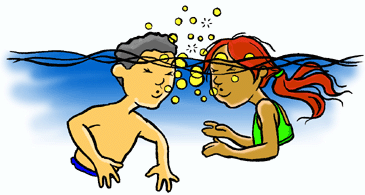|
Water Orientation
- Outcome D (K-3)-2

Working with a group of 10 to12 non-swimmers in
the shallow end of a pool, talk about blowing bubbles in the water.
(Students who are able to swim should be in small groups with a
leader working on appropriate swimming skills).
Have students try to blow bubbles. Have other
children demonstrate the correct blowing action.
Play a quick game of "Ring around the Rosy"
with each child blowing bubbles as they "all fall down".
See how many children can put their whole head under the water during
this song.
Ask the group what they would eventually like
to be able to do in the water. As they talk about using the diving
board or the slides or the deep pool, have them identify what must
first happen to make their wishes come true. Ask them if they will
have to extend some effort to get to their goal. (This can be a
type of goal setting for the students.)
Have the children work with a partner to show
a certain number of fingers for the other to look at while their
head is under the water. Then have them blow bubbles as well as
keep their eyes open under the water. Positive reinforcement is
important as they take the first step towards making their personal
goal a reality.

Substitute any other game or activity that would
encourage the children to put their heads under water.
Use rings or toys that sink to encourage the children
to open their eyes and pick up objects.
For those students who are comfortable underwater,
have one partner stand with their legs in a straddle position (creating
a tunnel). The second partner propels themselves through the tunnel.
Reverse rolls.

These are clues that you have reached the outcomes
...
On the way back to school, have the students write down or talk
with a partner, what they would like to be able to do in the water
and what they can do to help this become a reality.
back
to top
|


